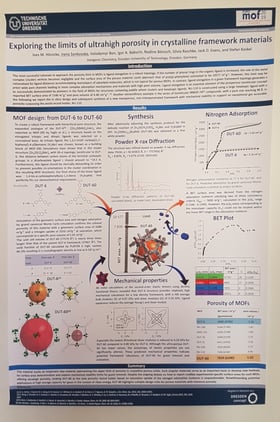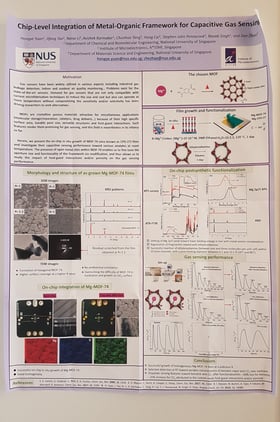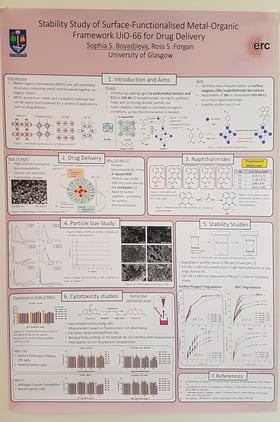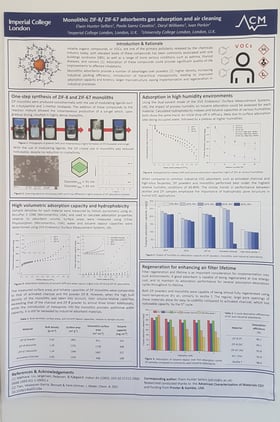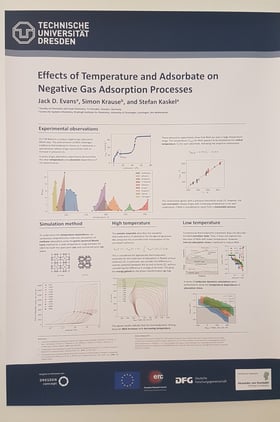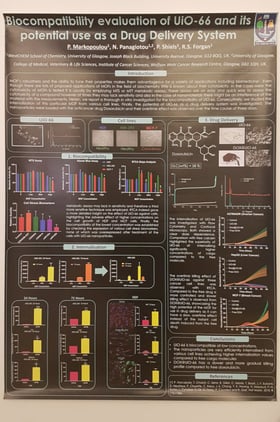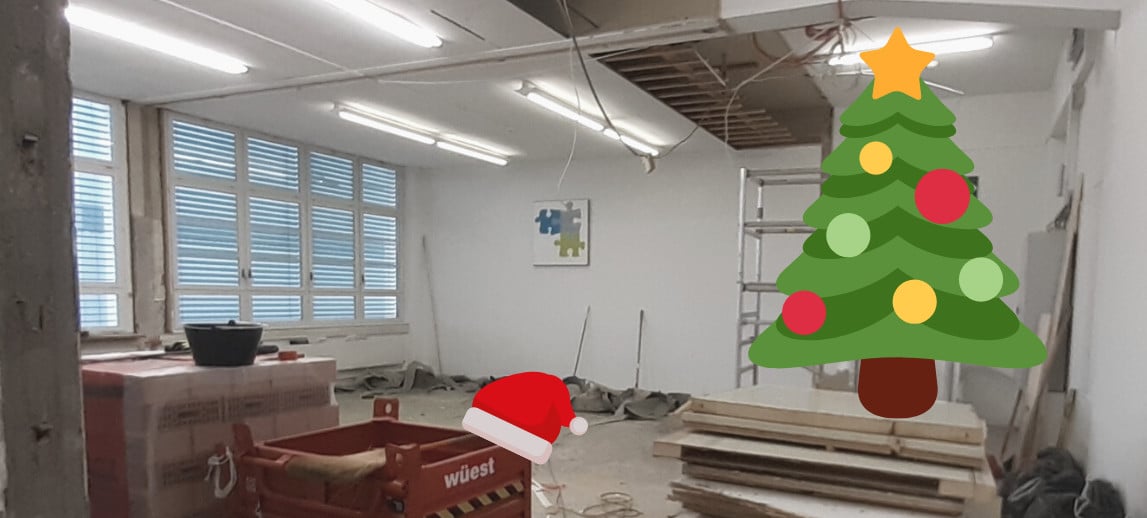Another year – another EuroMOF in Paris. I have been at the conference for three consecutive years – from the United States, the Netherlands, New Zealand to France. Over these years, I noticed how it advanced from a mainly scientific focus to a combination of science and industry. Which is something I am very happy about. Here is a personal recap of EuroMOF 2019 in Paris.
Best-of people
The MOF community is spread around the globe, so you don’t get to meet each other as often. Meeting up with project partners, scientific advisors, students and professors at such an event makes it even better.
Over 450 delegates from 37 countries joined the conference and presented the latest discoveries around MOFs. I was most excited to meet multiple novoMOF customers, who followed my invitation and used the conference as an opportunity to deepen their understanding of metal-organic frameworks. Furthermore, it was a great opportunity to meet the experts in this field.
Here are some highlights of the presentations:

Prof. Dr. Wendy Queen
Wendy Queen from EPFL Sion, Switzerland, focuses on the design of highly stable MOF/polymer composites for the extraction of metal ions from complex aqueous mixtures. She presented a MOF-based solution to remove metal contaminants from drinking water. Her water purification technology can be applied for mercury, lead and high-value metals such as gold.
Stefan Kaskel from the Fraunhofer Institute IWS, Germany, and his researchers presented unusual adsorption phenomena of MOFs such as breathing effects, the reversible switchability from a porous open state to a less porous contracted state, and the counterintuitive behaviour of negative gas adsorption (NGA). The latter can be utilised to improve adsorption systems.

Dr. Ross Forgan
Ross Forgan from the University of Glasgow, UK, shared his insights and comprehensive research into drug delivery from Zr MOF nanoparticles. These MOFs have suitable stability and low toxicity for biological applications. He has shown that selective anticancer cytotoxicity can be achieved with MOFs by selecting the right building blocks.
Mohamed Eddaoudi from the King Abdullah University of Science and Technology in Saudi Arabia (KAUST) hosted one of the many sessions at the conference and was recently invited to World Economic Forum to present carbon capture technology based on MOFs. Capturing Carbon with MOFs could be a game changer in the fight against global warming.
Christian Doonan from the University of Adelaide, Australia, presented his achievements with “MOFs at the Biointerface”, and described the approach to encapsulating bio-macromolecules within MOF crystals. They showed that the method is highly versatile. They showed the encapsulation of proteins, metalloenzymes, carbohydrates, and DNA within MOFs.
Jorge Gascon, another professor from the KAUST, presented on “MOF and MOF-derived materials for sustainable catalytic applications”. He stressed the advantages that metal-organic frameworks and their derived materials offer in the design of advanced heterogeneous catalysts, with special focus on sustainable applications, namely CO2 valorisation via thermal and electrochemical catalysis and in diverse photocatalytic transformation.
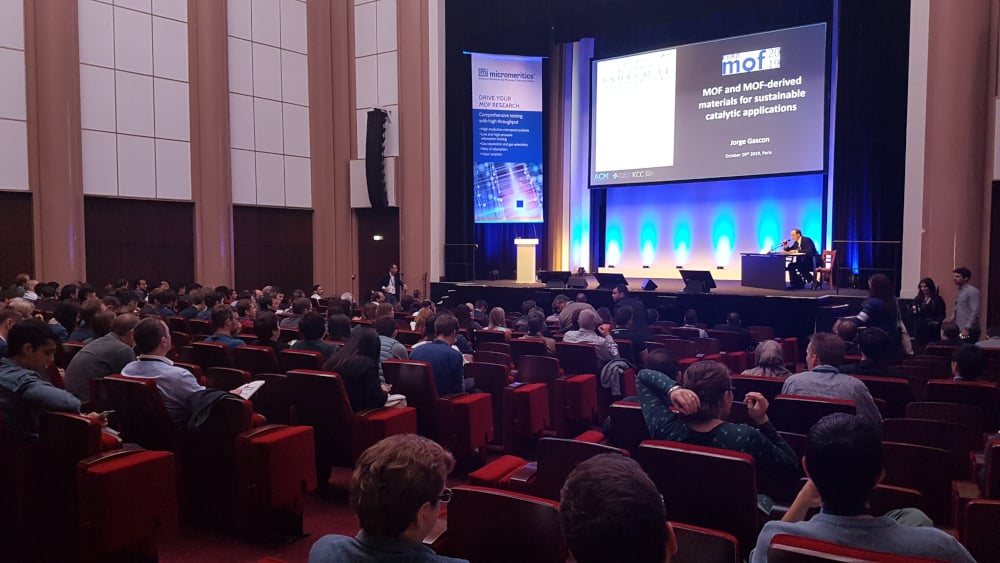
Jorge Gascon, professor at the KAUST, presented on “MOF and MOF-derived materials for sustainable catalytic applications”
There were many more people and I really enjoyed talking to them or listening to their presentations – even though I didn’t mention you here!
Best-of poster presentations – officially
Not every publication can be featured on the large stages, so here are the winners of the poster session, selected by the International Scientific Committee.
Aleksandr Sapianik from the Nikolaev Institute of Inorganic Chemistry, Russia, showed their work on Preorganized heterometallic MOFs for C3Hx and benzene/cyclohexane separation.
Harinaa Amer Hamzah from the University of Bristol, UK, presented their research on Surface Modification of Metal-Organic Frameworks with Substituted Azobenzenes for Controlled Hydrogen Trapping and Release.
Olga Trukhina from EPFL Sion, Switzerland, demonstrated her approach to use MOFs for catalytic reactions relevant for production of sweeteners, health-care intermediates and biofuels with a Porphyrin-based MOF with Zr8 oxo-cluster for aldose epimerization.
Isil Akpinar from the Aksaray University, Turkey, reported her Investigation of Efficient MOF Adsorbents for Pharmaceuticals and Endocrine Compounds Removal from Water.
Katharina Schmitz from RWTH Aachen, Germany, presented her research to incorporate chiral information into the MOF CFA-18: A newly developed homochiral metal-organic framework (MOF) with an enantiopure rigid -backbone triazolate ligand.
Bethany Connolly from the University of Cambridge, UK, showed her work on The Future of Fuel: High Density Gas Storage in Monolithic Metal-Organic Frameworks effectively reaching the US Department of Energy’s ambitious target for methane storage.
My own best-of posters
Apart from the winners of the poster presentation, there were many that were just as interesting. Here is my own best-of posters:
Exploring the limits of ultrahigh porosity in crystalline framework materials
Dr. Ines M. Hönicke, Dr. Irena Senkovska, Dr. Volodymyr Bon, Dr. Igor A. Baburin, Nadine Bönisch, Silvia Raschke, Dr. Jack D. Evans and Prof. Dr. Stefan Kaskel
A new mesoporous metal–organic framework (MOF; DUT‐60) was conceptually designed in silico using Zn4O6+ nodes, ditopic and tritopic linkers to explore the stability limits of framework architectures with ultrahigh porosity. The robust ith‐d topology of DUT‐60 provides an average bulk and shear modulus (4.97 GPa and 0.50 GPa, respectively) for this ultra‐porous framework, a key prerequisite to suppress pore collapse during desolvation. Subsequently, a cluster precursor approach, resulting in minimal side product formation in the solvothermal synthesis, was used to produce DUT‐60, a new crystalline framework with the highest recorded accessible pore volume (5.02 cm3 g−1) surpassing all known crystalline framework materials.
The new world-record surface in metal-organic frameworks!
Translocation of Enzymes into a Mesoporous MOF for Enhanced Catalytic Activity Under Extreme Conditions
José Navarro-Sánchez, Neyvis Almora-Barrios, Belén Lerma-Berlanga, J. Javier Ruiz-Pernía, Victor A. Lorenz-Fonfria, Iñaki Tuñón and Carlos Martí-Gastaldo
Enzymatic catalysis is of great importance to the chemical industry. However, we are still scratching the surface of the potential of biocatalysis due to the limited operating range of enzymes in harsh environments or their low recyclability. The role of Metal–Organic Frameworks (MOFs) as active supports to help overcome these limitations, mainly by immobilization and stabilization of enzymes, is rapidly expanding. Here we make use of mild heating and a non-polar medium during incubation to induce the translocation of a small enzyme like protease in the mesoporous MOF MIL-101(Al)-NH2. Our proteolytic tests demonstrate that protease@MIL-101(Al)-NH2 displays higher activity than the free enzyme under all the conditions explored and, more importantly, its usability can be extended to extreme conditions of pH and high temperatures. MOF immobilization is also effective in providing the biocomposite with long-term stability, recyclability and excellent compatibility with competing enzymes. This simple, one-step infiltration strategy might accelerate the discovery of new MOF-enzyme biocatalysts that meet the requirements for biotechnological applications.
Chip-Level Integration of Metal-Organic Frameworks for Capacitive Gas Sensing
Dr. Hongye Yuan, Dr. Jifang Tao, Dr. Nanxi Li, Dr. Avishek Karmakar, Dr. Chunhua Tang, Dr. Hong Cai, Prof. Stephen John Pennycook, Dr. Navab Singh and Prof. Dan Zhao
Metal-organic frameworks (MOFs), constructed by alternative assembly of metal centers and organic linkers, have emerged as a novel family of porous materials with crystallinity.[3] Because of their large specific surface area, tunable pore size, versatile topologies and potentially tailored-made host-guest interactions, MOFs have been exploited for numerous applications including molecular separation, catalysis, and chemo/bio-sensing. The unique features of MOFs also render them promising for application in gas detection and this field is nevertheless in its infancy so far.
We present herein the in-situ growth of MOF-74 films with coordinatively unsaturated metal sites on interdigitated electrodes and investigate their room temperature sensing performance toward various analytes. The presence of open metal sites is expected to endow a better sensing performance in terms of response, selectivity, and also allows us to fine tune the aperture size and functionality of the framework. The resultant capacitive sensor exhibits selective detection with high sensitivity toward benzene and carbon dioxide (CO2). Functionalization upon MOF-74 skeleton leads to distinct gas sensing behaviors toward the relevant gases due to the differentiated interaction pairs. This study provides new perspectives for the fabrication of MOF-based capacitive sensors with higher selectivity and lower power consumption targeted for ultratrace gas detection.
Stability Study of Surface-Functionalised Metal-Organic Framework UiO-66 for Drug Delivery
Sophia S. Boyadjieva, Ross S. Forgan
Surface stability of nanoparticles is of great importance when used in drug delivery. That is because the surface can be used to attach targeting groups, solubilising polymers, stimuli-responsive release mechanisms, or drugs. We will report a comprehensive study of the surface functionalisation of the modulated Zr MOF UiO-66 to assess surface stability. A number of naphthalimides have been synthesised and incorporated on the surface of the MOF, in order to compare and contrast the effect of the different anchoring groups of the surface reagents. Initial results show that a small variability in the length of the surface reagents leads to significant differences in the surface stability in simulated biological conditions. Scanning Electron Microscopy (SEM) and Dynamic Light Scattering (DLS) show that MOFs are of the desired size for drug delivery. Initial cytotoxicity studies show that surfacefunctionalised UiO-66 nanoparticles are biocompatible. These results will have important implications for the design and applicability of MOF-based drug delivery devices.
Jack D. Evans, Simon Krause and Stefan Kaskel
Unusual adsorption phenomena, such as breathing and negative gas adsorption (NGA), are rare and challenge our thermodynamic understanding of adsorption. In particular, NGA was recently discovered in a series of isoreticular materials and fundamental understanding of this process is desperately required for the discovery of new metastable materials with this exotic property.
We present an extensive investigation of gas adsorption in DUT-49, a material which features an NGA step. A combination of experiments, featuring more than 10 gases and vapours at various temperatures, and molecular simulation were used to outline the critical temperature range to produce NGA. This in-depth analysis has highlighted the crucial thermodynamic and kinetic considerations for discovering new NGA materials.
Fluorescent surface functionalisation of metal-organic framework nanoparticles to target hard-to-treat cancers
N. Panagiotou, Ross S. Forgan
The survival rate of cancer patients has significantly increased over the past four decades, owing to advances in pharmacological and surgical interventions, as well as improved patient care. Nevertheless, there exists a number of hard-to-treat cancers, such as those of pancreatic, brain, lung and oesophageal origin, that are still defined by low survivability and whose survival rates have remained largely unaffected over the same period of time. These cancers are difficult to remove surgically, they are highly invasive and drugs cannot efficiently reach them. Hence, other approaches have been investigated for their treatment through the targeted delivery of drugs with the use of nanoparticles. Metal-organic framework nanoparticles (NMOFs) have currently been established as the ideal biocompatible candidates to fulfil this role as they offer high drug loading capacity, targeting efficiency through surface functionalisation and increased bioavailability of drugs through controlled drug release in the delivery site. Thus, NMOFs have been proposed as a new delivery tool to transport drugs to tumours in large concentrations and with high specificity, minimising unwanted off-target toxicity.
Here, we propose the use of a fluorescent functionalised NMOFs to readily assess drug loading capacity, targeting specificity and cellular internalisation for hard-to-treat cancers. Specifically, we employed a photochemical approach to surface functionalise the biocompatible NMOF UiO-66 with a fluorescent linker. This photoreaction was established as a self-reporting system, where the fluorescent product could be readily used to evaluate both the functionalisation process and drug loading capacity of the NMOF. Furthermore, the resulting fluorescent NMOF allowed for the study of cellular internalisation of the functionalised UiO-66, targeting specificity and subsequent assessment of the drug release profile. Our results suggest that this self-reporting system could be employed for the assessment of NMOF surface functionalisation and cancer drug loading processes, as well as for the study of cellular internalisation, targeted drug release and organismal biodistribution.
I. Abánades Lázaro, S.Hddad, S. Sacca, C. Orellana-Tavra, D. Fairen-Jimenez and Ross S. Forgan
The efficacy of many potential anticancer chemotherapeutics is limited by problems such as poor stability, bioavailability, and off-target effects. As such, targeted drug delivery devices, capable of delivering and releasing drug molecules selectively at sites of disease, have been the subject of significant academic interest and are now being translated to the clinic. Metal-organic frameworks have the advantages of tuneable structures (and thus biocompatibility), large drug loadings, ease of functionalization, and controlled degradation.
We will present our comprehensive research into drug delivery from Zr MOF nanoparticles, which have suitable stability and low toxicity for biological application. By focussing on the surface modification of MOF nanoparticles, we have shown that selective anticancer cytotoxicity can be achieved. Development of “click modulation” to selectively modify surfaces of UiO-66 nanoparticles with polymers and biomolecules through bioconjugate chemistry is orthogonal with drug loading, and surface modification is shown to have a significant influence on the method of nanoparticle endocytosis by cancer cells. By controlled targeting of caveolae-mediated cellular uptake, the MOFs can partially avoid lysosomal degradation, and thus enhance the efficiency of delivered cargo. As an example, we have used the simple small molecule dichloroacetate as a therapeutic probe, enhancing its cytotoxic effect by three orders of magnitude by ensuring it is delivered by the MOFs into the cytosol. Dichloroacetate can also be “defect–loaded”, leaving MOF porosity available for conventional loading of a second drug to synergistically enhance cytotoxicity. Selective cytotoxicity towards a number of cancer cell lines is observed, while comprehensive experiments suggest no negative immunological response. A range of Zr MOFs are now being assessed in our lab for stability, biocompatibility, and targeted drug delivery by a suite of novel techniques, with highly promising results suggesting they are prime candidates for clinical translation.
I. E. Men’shchikow, A. V. Shkolin, O.V. Solovtsova, A. A. Fomkin, E.V. Khozina, M. K. Kniazeva
My personal favorite – combining MOFs with new technology!
The purpose of current research is development of the technology of synthesis and complex investigations of MOF-based functional porous materials and composites of different chemical composition for small-scale onboard gas storage systems of drones and ground robotic vehicles.
MOF samples based on metals of valences II and III and organic ligands of BTC–1, 3, 5- benzenetricarboxylate, BDC–1, 4-benzenedicarboxylate and BTB–1, 3, 5-benzenetribenzoate were synthesized on the basis of newly developed original method – Cu-BTC, ZnBTB, Al-BDC, Al-BTC, Fe-BDC и Fe-BTC. Obtained samples had the following structural-energy properties: volume of micropores W0 = 0,38-0,83 cm3/g, average half-width of micropores x0 = 0,36-0,90 nm, specific surface area SBET = 851-2240 m2/g. After that, powdered samples were shaped into monolithic blocks using different technological regimes at different compressing pressures, using different binders and adding various composite elements. According to the results of optimization of the molding parameters, it was possible to achieve a significant preservation of the porous structure of the obtained samples compared to the initial one, within twofold increase of bulk density and improvement of mechanical properties. The adsorption of methane and hydrogen was measured on the high-pressure volume-gravimetric experimental unit in the temperature range from 177 to 333 K and pressures up to 40 MPa. On the basis of the data obtained, the best samples for testing were selected as a part of the prototype of the onboard gas storage system.
Such parameters of obtained molded materials as specific storage capacity and cyclic stability were investigated using special experimental unit at temperatures 233-333 K and pressures up to 20 MPa. Mechanical strength of the samples was studied as well. As the result, it was shown, that one the most promising materials was a composite on the basis of Al-BTC, which demonstrated the highest volumetric storage capacity of methane – 270 m3(NTP)/m3 at 273 K and pressure about 10 MPa. The next stage of work is manufacturing and testing of the prototype of onboard methane and hydrogen accumulation systems for drones using the developed materials.
So, was it worth going?
Yes, for the people I met and the insights I got from presentations, posters and discussions.
Until next year!

